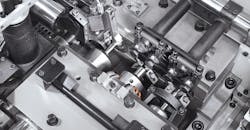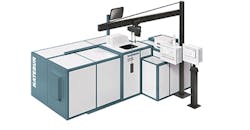Speed, Precision, and Flexibility Drive Hot Forming Design
In any discussion of manufacturing innovation, there is some tension over the inspiration of new technology: Does the new idea descend from demands made by consumer markets, or is it the result of some important design or scientific breakthrough? Once the innovation catches on, however, this debate may not matter. It’s the developers goal to get to that moment as quickly as possible.
The forming technology developers at Hatebur Umformmaschinen AG will surely accomplish that much. The HOTmatic hot forming machine series is long established among forgers producing precision parts in high volumes: wheel flanges, gear wheels, rolling bearing rings and nuts. For obvious reasons, the automotive manufacturing sector is an important destination for HOTmatic products. Over several decades since the Swiss company introduced the first HOTmatic system, it has developed a dozen or so variants to suit the scale of operation that customers require.
The latest innovation is the HOTmatic AMP 20 N, which Hatebur engineers developed specifically for hot forming cam lobes.
In a combustion engine, the cam lobes are fixtures located on a camshaft that open and close the intake and exhaust valves in time with the motion of the piston. Cam lobes control the valve lift, and there is a direct correlation between the shape of the cam lobes and the performance of an engine at different speeds. With the HOTmatic AMP 20 N, Hatebur indicated it aims to improve the efficiency and productivity of suppliers of automotive components.
“Almost all of the forged cam lobes supplied worldwide are produced on Hatebur machines,” according to CEO Thomas Christoffel. “With the development of the HOTmaticAMP 20 N, we are responding to new trends… We want to make our customers even more productive and strengthen our market leadership.”
Most of the forged cam lobes are produced on two earlier versions of the machine, the HOTmatic AMP 30 S and 20 S, and the results are reliable and efficient. But, the lightweighting design prerogatives of automakers inspired the new machine design. “The trend goes toward thinner cam lobes in order to support the lightweight construction of engines,” Christoffel explained. Thus, Hatebur’s R&D division initiated a fundamental approach to their project, focusing on cam lobes that are just 8-mm thick, in contrast to the 12-mm standard that has been the basis for previous designs.
“The thinner cam lobes impose the highest demands on the forming machine,” according to the Hatebur executive, “in particular in terms of the shearing quality, the pressing force and the part transfer.”
The resulting machine design “is ideal for (manufacturing) thinner cam lobes with high surface quality, outstanding wear-resistance and precise geometries,” Christoffel said. And, while the production of lighter automotive cam lobes was the intended function and the focus of the design initiative, Hatebur emphasized that it is not offering a single-purpose machine. “The AMP 20 N is flexible and can be used in a wide variety of applications,” Christoffel said.
Operating with a total press load of 1,500 kN — the designers specified a reinforced machine body to ensure the necessary stability — the AMP 20 N nevertheless maintains consistent precision in forming parts and production speed.
“In three forming stations and with a maximum of 200 strokes per minute, the AMP 20 N produces cam lobes with an outer diameter of up to 48 mm out of raw parts with 24 to 217 grams,” according to Hatebur marketing and sales chief Reinhard Bührer.
Steel bars up to 6 meters long and heated to almost 1200°C are brought into position by four feeder rollers, powered by servo drives. “When thin parts are being processed, the transport between the forming stations needs utmost accuracy to achieve an ideal surface quality,” Bührer emphasized.
One critical element of the process design is the shearing unit. “This is where parts with a cut-off length of 20-45 mm are made,” Bührer noted. “Just as on other Hatebur machines, the surface quality of the shear plane is outstanding. The forming of the parts can start from the first station.”
Almost all standard cam sizes for passenger cars can be produced on the AMP 20 N. “Most of the tools are compatible with the HOTmaticAMP 20 S,” according to Bührer. “Low maintenance and operating costs as well as the high productivity lead to an exceptional cost-benefit ratio.”

